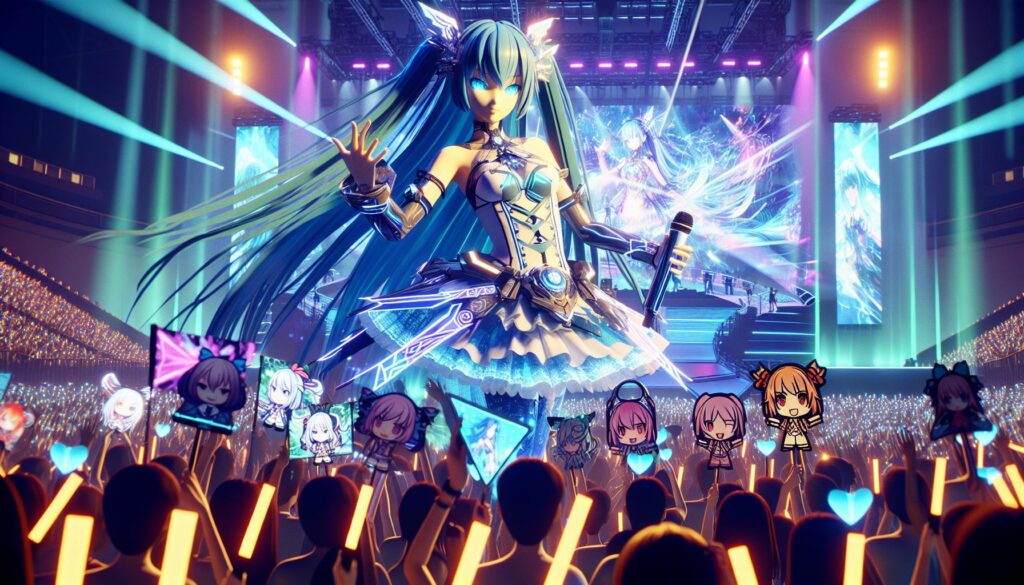Anime has a unique way of captivating audiences, and one character that stands out is Hatsune Miku. As a virtual idol and a pioneer in the world of Vocaloid, Miku has transcended traditional boundaries of music and animation. Her vibrant personality and catchy tunes have garnered a massive following, making her a cultural phenomenon.
In this article, I’ll dive into the fascinating world of Hatsune Miku, exploring her origins, impact on the anime industry, and the reasons behind her enduring popularity. Whether you’re a seasoned fan or just curious about this digital diva, there’s something here for everyone. Join me as we uncover the magic of Miku and her influence on both anime and music today.
Key Takeaways
- Hatsune Miku, a virtual idol and Vocaloid pioneer, represents a unique intersection of music and technology, captivating audiences since her debut in 2007.
- Miku’s vibrant design and versatile voicebank allow for diverse music creation, enabling collaborations across various genres, appealing to both anime enthusiasts and music fans.
- The character has evolved into a cultural icon, influencing fashion, art, and live performances, attracting large audiences through innovative holographic concerts.
- Central themes in Miku’s narrative focus on identity, technology, community, and the interplay of transient live experiences with permanent digital art.
- Miku’s success is bolstered by an active fanbase engaging in cosplay, fan art, and merchandise, contributing to a vibrant culture around her persona.
- Critical acclaim highlights Miku’s innovative performances, diverse musical range, and narrative depth in anime adaptations, emphasizing her impact on contemporary entertainment.
Anime:fjn0d9ax9xi= Miku
Anime:fjn0d9ax9xi= Miku represents the intersection of virtual entertainment and cutting-edge technology. This character embodies the Vocaloid genre, characterized by synthesized singing. Originating in 2007, Miku made her debut through Crypton Future Media’s software, quickly gaining traction within the music community.
Miku’s design features long teal hair and a futuristic outfit, visually appealing to both anime enthusiasts and music fans. The character’s versatility allows DJs and producers to create music across various genres, from pop to electronic. Miku’s voicebank, an amalgamation of multiple vocal samples, enables a wide range of vocal expression, making collaboration effortless for creators.
The impact of Anime:fjn0d9ax9xi= Miku extends beyond music. She has become a cultural icon, influencing fashion, art, and even live performances. Miku concerts employ holographic technology, enabling fans to experience live shows that blend reality and digital artistry. These performances attract thousands of attendees, showcasing Miku’s multifaceted appeal and remarkable reach in popular culture.
Numerous merchandise items, including figurines, apparel, and home decor, highlight the fervent fanbase surrounding Miku. Fans actively engage through cosplaying, fan art, and online communities, fostering a vibrant culture that celebrates her legacy. This interaction not only cultivates loyalty but also ensures Miku’s relevancy in an ever-evolving entertainment landscape.
By navigating the domains of music and anime, Miku has redefined how audiences consume and interact with digital art forms. Her status as a virtual idol continues to grow, proving the undeniable influence of Anime:fjn0d9ax9xi= Miku on contemporary culture.
Storyline and Themes

Hatsune Miku’s storyline intertwines with her role as a virtual idol, creating a captivating narrative that reflects the intersection of technology and creativity. The themes explore identity, innovation, and the relationship between fans and digital culture.
Main Plot Summary
The core storyline centers on Miku’s journey as a virtual performer, navigating the music industry while engaging with fans. Each concert serves as a narrative event, showcasing her evolution through various musical genres. The anime adaptations highlight her interactions with creators and fans, emphasizing the collaborative spirit inherent in her music. Each episode captures behind-the-scenes moments, revealing the challenges and triumphs of a digital diva thriving in a rapidly changing entertainment landscape.
Recurring Themes
The series presents several recurring themes:
- Identity: Miku’s character challenges traditional concepts of stardom by existing purely in a digital realm. Her identity evolves through the music created by diverse producers and embraces various personas, reflecting the multifaceted nature of fandom.
- Technology and Art: The synergy between technology and creativity underscores Miku’s story. Holographic concerts highlight how advancements in technology redefine performance art, making it accessible to a global audience.
- Community and Collaboration: Miku’s narrative emphasizes the importance of fan engagement. Through user-generated content, fans contribute to her persona, fostering a sense of community that thrives on collaboration and shared passion.
- Transience and Permanence: Miku encapsulates the contrast between fleeting moments in live performances and the eternal nature of digital art. While each concert is a temporary experience, recordings and fan creations preserve these moments indefinitely, blending the ephemeral with the timeless.
These themes resonate with audiences, reinforcing Miku’s status as a cultural icon who embodies the dynamic landscape of modern entertainment.
Character Analysis

Hatsune Miku embodies a blend of music, technology, and artistry, captivating audiences across multiple platforms. Her unique character design and personality contribute significantly to her popularity and cultural impact.
Protagonist Description
Hatsune Miku, as a virtual idol, showcases a distinct character design characterized by long teal hair styled into twin-tails, paired with a futuristic outfit that blends pop aesthetics and anime elements. Miku’s personality reflects an energetic and friendly demeanor, appealing to a broad audience. Her voice is not just an auditory experience; it projects emotions ranging from joy to melancholy, allowing for vast creative expression in music creation. Miku’s presence as a digital singer underscores themes of innovation, inviting fans to explore collaborative creation while challenging conventional notions of celebrity.
Supporting Characters
Supporting characters in the Miku narrative enhance her story and provide depth to the overarching themes. These characters often include:
- Vocaloid Collaborators: Professional musicians and producers who utilize Miku’s voicebank to create diverse musical pieces showcasing Miku’s versatility.
- Fan Characters: Fans often create their own characters within the Miku universe, reflecting personal interpretations and expanding the interactive nature of her story.
- Other Vocaloids: Characters like Kagamine Rin and Len, and Megurine Luka, interact with Miku in performances, representing collaboration and competition in the digital music landscape.
Together, these supporting figures contribute to the community around Miku, fostering engagement and collaboration, and enriching the narrative through various projects and performances.
Animation and Art Style

Hatsune Miku’s animation and art style play a crucial role in her appeal, merging vivid visuals with dynamic animation techniques. The blend of traditional anime aesthetics with modern digital artistry captivates audiences and enhances her performances across various platforms.
Visual Aesthetics
Miku’s character design exhibits a vibrant palette, primarily featuring teal hair, which symbolizes her digital nature. Her futuristic outfit combines elements of cyberpunk and pop culture, attracting a wide audience. Characteristic accessories, such as her trademark headset and plaid skirt, contribute to her iconic status. Artwork inspired by Miku often incorporates whimsical themes and colorful environments, showcasing a distinct anime influence. The visual representation consistently emphasizes her spirited personality, inviting diverse expressions from artists worldwide.
Animation Techniques
Innovative animation techniques amplify Miku’s presence, particularly in concerts where holographic projections bring her to life. 3D animation technology allows for dynamic movements, enhancing the viewer’s experience. Techniques such as motion capture help convey human-like gestures and expressions, providing realism in performances. Additionally, seamless transitions between musical scenes and narratives in anime adaptations showcase storytelling through animation. The combination of these advanced techniques creates an immersive experience, inviting audience interaction and fostering a deeper connection with Miku as a digital performer.
Soundtrack and Voice Acting
Miku’s soundtrack features an eclectic mix of genres that showcases her versatility as a virtual idol. Each song highlights unique musical elements, creating a rich auditory experience.
Music Elements
Music elements in Miku’s tracks range from electronic pop to rock, often incorporating orchestral sounds and traditional Japanese influences. Producers utilize Miku’s voicebank to experiment with tempos, harmonies, and melodies. Notable songs such as “World is Mine” and “Senbonzakura” exemplify this diversity through catchy hooks and intricate arrangements. Collaborations with renowned producers amplify her sound, infusing established styles with innovative techniques. Live concerts feature remixes and arrangements, enhancing the overall audience experience and showcasing Miku’s adaptability.
Voice Performance
Voice performance plays a crucial role in Miku’s appeal. Her unique vocal synthesis technology allows for a wide range of emotional expression, from sweet and whimsical to powerful and energetic. The clarity and pitch of her voice resonate with listeners, creating an engaging atmosphere. Miku’s collaborations with various Vocaloid producers add depth to her character, as different styles and interpretations highlight her flexibility. Performances often include live singing augmented by holographic visuals, creating an immersive and interactive experience that captivates fans worldwide. Noteworthy live performances, such as Miku Expo, further demonstrate her magnetic presence and undeniable vocal talent.
Reception and Impact
Hatsune Miku’s reception has been overwhelmingly positive, reflecting her influence in both music and anime. Fans and critics alike recognize her as a groundbreaking figure that bridges technology and creativity.
Audience Response
Audiences respond passionately to Miku, demonstrated through vast online communities and fan interactions. Participation in events like Miku Expo showcases the dedicated fanbase, with thousands attending concerts worldwide. Merchandise sales, from figures to clothing, highlight fans’ commitment to Miku’s brand. Social media engagement frequently features fan art, cosplay, and music covers, indicating the character’s significant cultural presence. Many fans view her as more than an idol; they see her as a representation of digital culture’s evolution. Events like virtual concerts expand access, enabling global audiences to participate, thus enhancing community-building among fans.
Critical Reviews
Critical reviews often praise Miku for her innovative approach to music and performance art. Analysts note the seamless integration of holographic technology in live shows, resulting in immersive experiences that captivate audiences. Reviewers highlight her wide-ranging musical genres, acknowledging her collaboration with diverse artists and producers as key to her resonance across demographics. Critics also appreciate the narrative depth in her anime adaptations, which explore themes of technology and human connection. Scholarly articles on virtual idols frequently reference Miku as a case study in the intersection of digital innovation and entertainment, solidifying her critical acclaim in academic discussions regarding modern pop culture.
technology and creativity
Hatsune Miku isn’t just a virtual idol; she’s a transformative force in the worlds of music and anime. Her unique blend of technology and creativity has redefined how we experience digital entertainment. As I dive deeper into her vibrant universe, I can’t help but admire how she connects fans through collaboration and innovation.
Miku’s journey reflects the evolving landscape of modern culture, where virtual and real-world interactions intertwine seamlessly. Whether you’re a long-time fan or just starting to explore her world, there’s no denying the magic she brings to our lives. Embracing Miku means embracing a new era of entertainment where anything is possible.

